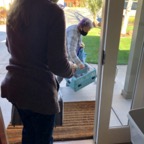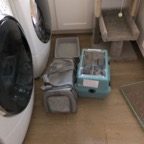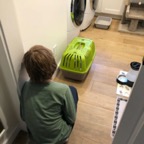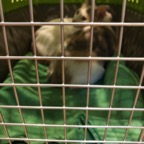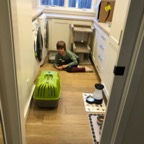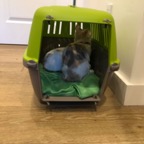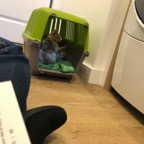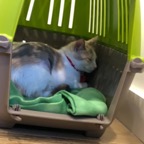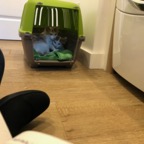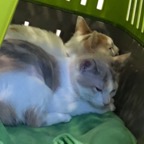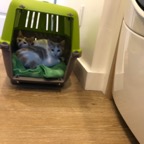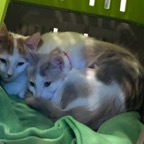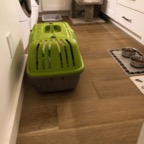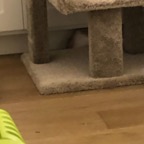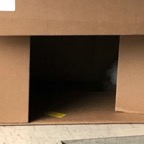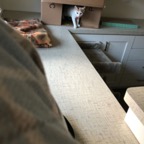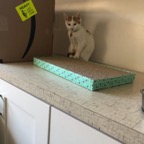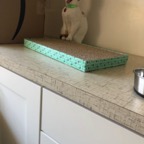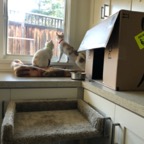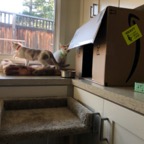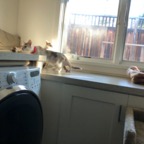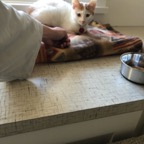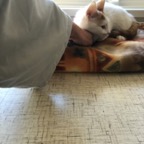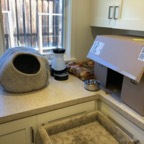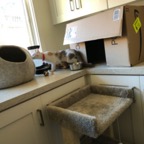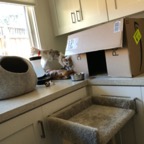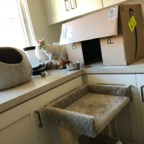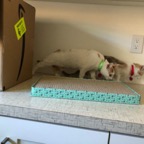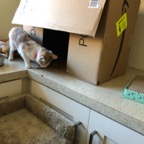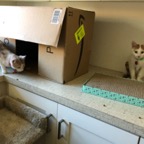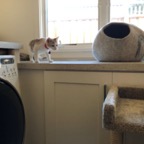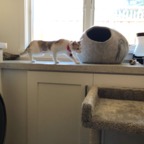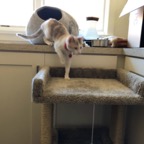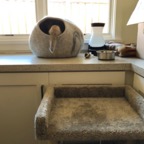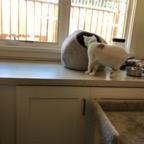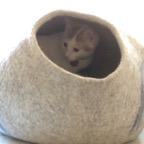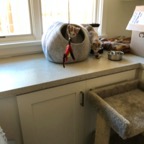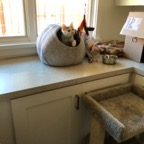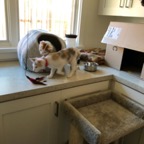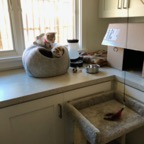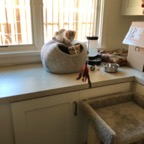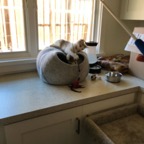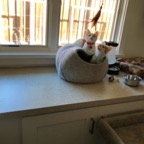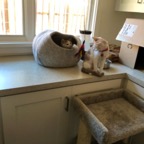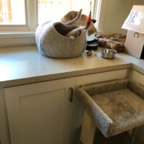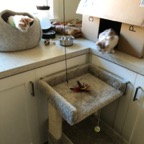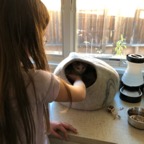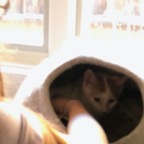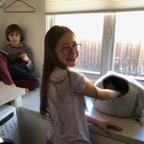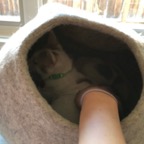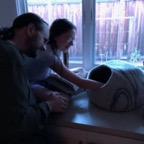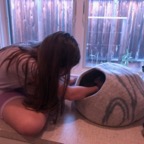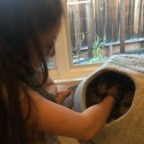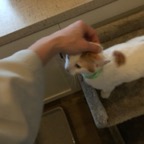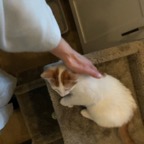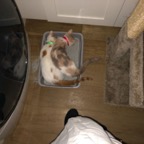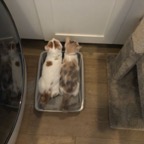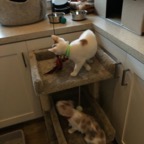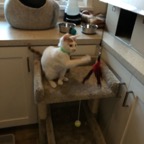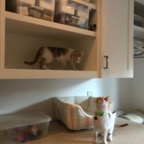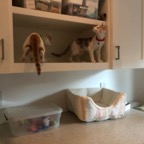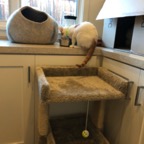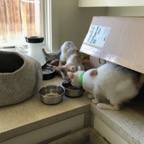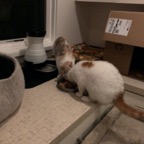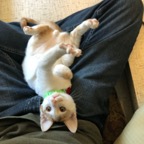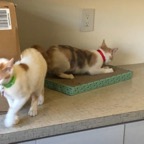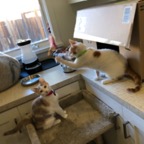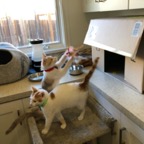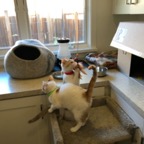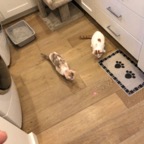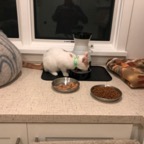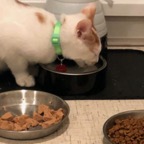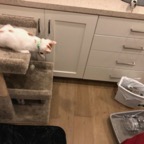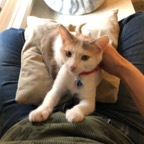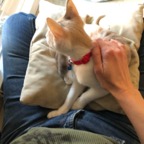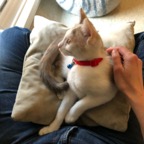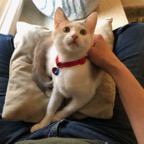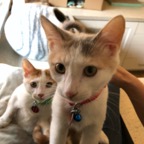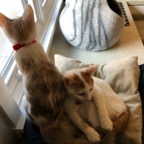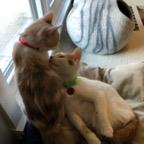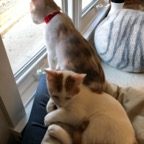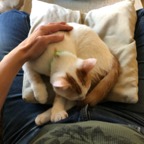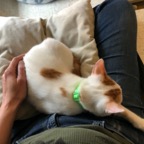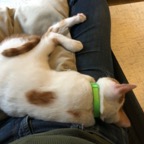Kitties' Arrival and First Week
On January 15th, our two kittens were going to arrive!
We were all VERY excited.
I’d done a lot of reading about how to receive new kittens and make sure their arrival and first days were as low-stress as possible, and got our relationship with them off to a good start.
The main thing was to give the kittens their OWN personal, enclosed, safe space to settle into. They would stay in that space for a week before we would let them into more of the house. That personal space would become their home base within the house, a safe space where they’d fine food, water, litterbox, comfortable sleeping spots, and places to hide. Once we established them in this home base we could let them into more of the house, a bit at a time, so they didn’t get overwhelmed. But their home base would always be a safe space for them to retreat to.
The overall goal was to psychologically root the cats into our home, so that our house would grow to be their home too. But this takes time. It’s like transplanting a plant – we had to let the cats’ root system establish itself in the new soil.
I’d seen this done multiple times up at Deer Hollow Farm when Lisa got new farm cats. She’d set up a crate and small wire enclosure for the new cat within a barn or shed, and would keep them in that enclosure for two weeks. Then she’d open the door of the enclosure and allow the cat to explore the barn or shed for two weeks. After that she’d open the barn or shed door and allow the cat outside. The hope was that the cat would consider the barn or shed “home” and would remain on the farm, returning to the barn or shed for food, water and shelter. If a farm cat is NOT established in this way, but is simply released onto farm, the chances are high that the cat would just leave. It would have no reason to consider the farm “home.”
Imagine if a human were kidnapped and dumped at a freeway rest stop. The human would have no reason to make a home at that rest stop, even though there’s water and nominal shelter and a vending machine with food. It would be very much a transitory thing: the human, surrounded by strangers in an unfamiliar environment, would simply take off.
So we needed to establish a safe space within the house to be the cats’ home base. We chose the laundry room: it was a good size, had a door we could close, and wasn’t a bathroom that we’d need to have access too. I got food and water bowls, a litterbox, cardboard boxes as hiding places, with polar fleece from my stash to make soft beds, and a cat tree (we were in touch with the fosterer who advised us on the right kind of cat tree). We also totally kitten-proofed the laundry room, which meant blocking off all the spaces around the washer and drier and removing anything dangling. The laundry room is also where we store craft supplies so we needed to make sure those were all shut away.
Then the BIG DAY arrived! The fosterer, whose name was Kathy, brought the kittens to our house at noon. She did not come in, due to the pandemic, but we assured her we had the kittens’ space all set up.
I took the two carriers to the laundry room and transferred the kitties to our own carrier and closed the door, then returned Kathy’s carriers to her. We talked for a while, then she left and the kitties were ours!
I really wanted to make sure this introduction went well, which meant managing the kids’ expectations and explaining very clearly what the kitties were going through, and what we could do to make them feel safe and secure. The sooner the cats felt safe, the sooner they could relax and start to bond with us.
This is one of the core practical lessons of animal behavior: understanding the likely inner state and perspective of an animal, then taking action calculated to get the response from the animal that you want. This approach is very different from taking action based on your OWN internal emotional state, and assuming that the animal is on the same page as you and will respond in the way that you want. It involves being very sensitive to the animal’s ‘state of mind,’ and responding to that, while managing or even ignoring your own state of mind. This lesson can be extrapolated to humans, too, of course: being aware of the other person’s likely state of mind, and meeting them there, rather than imposing your own state of mind.
What this meant in a practical sense was not overwhelming the kitties with lots of attention or excitement. This goes against our natural inclinations when we’re excited and want to greet someone: humans want to get in close, laugh, talk, ooh and ah, reach with their hands, touch, squeeze, hold, loom with their bodies, and make sudden movements. When greeting new kittens, the humans might try to pull the kitties from the carrier and cuddle them right away, for example.
All these natural human behaviors would be very scary to two kittens who had just left the only home and the only human they’d ever known. Being hauled out of the carrier by total strangers and then squeezed would probably terrify them and cause them to claw themselves away, then find a deep place to hide, away from these terrifying, shrieking, grabby monkeys. Welcome them like that and we’d be starting them down the path of fear and mistrust.
I wanted to avoid this scenario and get the kitties off to a good start.
First thing we needed to do was to make the kitties feel safe and unthreatened, and since we couldn’t reassure them with words, we could only SHOW them, through our behavior, that they were going to be okay.
This meant leaving the carrier in the laundry room with the carrier door open and no humans in there for a while. This would give them time for their world to stop reeling. Once things stopped moving they could start to look around just a little bit. Then they could start to glance outside the carrier just a little bit, and smell their environment, and start figuring out where they’d landed. I’d bought the same kitty litter and the same foods that they’d been raised on, so those smells should be familiar to them.
So I put the carrier in the laundry room, with the carrier door open and facing away from the door to the laundry room. Both kittens were pressed together at the far end of the carrier, curled up, very much awake and alert and not moving at all. They were really, really scared and had no idea what was going on. The only familiar thing in the entire world for them was each other, so they squeezed together as tight as they could.
After an hour or so, I went in there with a book and a pillow and sat on the floor near the carrier. I just sat there, reading, and not looking at them directly. The direct two-eyed stare of a human is quite threatening (it’s the predator’s binocular stare that you also see in raptors, snakes, and wolves) so I did not turn my face towards them. I just glanced at them out of the side of half-closed eyes, and read my book. I wanted them to realize that I was a low-energy, non-threatening human that could safely be ignored or, if they felt like it, approached.
The two of them watched me attentively for a long time, still pressed against each other and the back of the carrier. Then, since they’d just had a HUGE day and I didn’t seem to be an immediate thread, they started to nod off. This was a great sign: it meant that they felt safe enough, in my presence, to fall asleep. That was great. I just sat in there and read my book for several hours.
In the late afternoon I quietly left the laundry room. I peeked in again at around 6 p.m. and was delighted to see that one of them – the female – had left the carrier and was hiding behind the cat tree! She had gotten comfortable enough to leave the carrier, and perhaps was seeking food or water or a litter box, which meant that she no longer felt she was in imminent danger of death and could perhaps attend to some of her needs.
As far as I could tell, they did not eat or drink or go to the bathroom at all that first day, from the stress of the move. I was a little anxious about that but figured they’d be okay if they didn’t eat for a day. Our goal was to make them feel safe, and as soon as they felt safe they should start eating and drinking.
The next day I checked on them first thing, and was delighted to see them hiding in the cardboard box I had set up for them. No telling how much they had explored overnight. I’d brought in a pillow and my book again, and I settled in for more hours of reading near them, and not looking at them, and just letting them get used to my presence.
They stayed hidden in the cardboard box for 20 minutes, but then the male peeked out! It was very slow, but he eventually got the courage to venture outside the cardboard box even with me in the room. An hour later, he was exploring the counter. The female came out too, and, cautiously they looked out the window (which meant turning their backs on me – a good sign of trust).
I quietly placed a toy on the counter and they approached it and sniffed it, very cautiously, which meant approaching me a little bit. All good.
A little while later, the male curled up on a folded piece of fleece, and I reached out toward him with my hand. I didn’t try to pet him – I felt that would be much too pushy. Instead, with my fingers curled under, I put my hand on the fleece a few inches from him. He looked at it for a while, then approached, and, to my delight, he rested his chin on my hand! He didn’t have to do that – that was him approaching me and trusting me.
At midday I returned and put a few kibbles on the counter. I didn’t know if the bowl I got for them was too tall or scary, so I took a couple kibbles out and made a less-intimidating pile of them near the entrance to their box. A bit later I tried laying a trail of single kibbles about 8 inches apart.
I was also very glad to see that the litter box had been used!
I had ordered a felt, cave-shaped “nest” for the kitties and it arrived during the day, so I took it in and placed it on the counter for them. The female approached it and retreated several times, then discovered the opening and climbed in! It was a great little next: round and warm and soft, much better, in my opinion, than the box.
I tried a wand toy in the afternoon, too. This is a toy like a fishing rod with a shoestring tied to the end, and a “lure” made of feathers attached to the end of a string. I went into the laundry room again and found the male in the felt cave, and dangled the toy near the entrance. Almost in spite of himself he attended to it, watching it, and then, to my delight, batting at it with a paw!
That meant he was comfortable enough to play around me, and that was great. I had fun dangling it and bobbing it and watching them both try to catch it. The play was still subdued and cautious, mostly involving paw and leg movements and not whole body movements, but they were relaxed enough to play!
The evening of that second day Ellie went in there too, sat on the counter, and just put her hand inside the felt cave next to one of the kitties, and was able to pet the male!
The next day, day 3, I went into the laundry room first thing and was able to pet the male on the head. He even leaned into my hand and started purring! I was also delighted to see them use the litterbox. Interestingly, they used it TOGETHER, in synchrony, side by side, hahaha.
We kept going in there with books, day after day, and sitting with them. There was definitely a sense of them relaxing and getting more comfortable by the third day. I finally saw them EAT, and they finished off their food bowls, which was a big deal. I did notice that their metal tags clinked against the edge of the bowl, which might be scary enough to cut down on their eating, so I got two food bowls with lower sides that day. They could eat out of those without metal clinking, and I think that helped.
They started playing with the lure with big grabs, and they were interested in the laser pointer, and I saw them drink. By the end of the week they were climbing into our laps! The male curled up in Mike’s lap, and when I went in there with a pillow, the female climbed into my lap and settled down, and was soon joined by her brother. Eventually, he fell asleep in my lap, an amazing thing!
The kittens were getting used to us, and were starting to feel comfortable with us and trust us. Our human-animal relationship was off to a good start!

